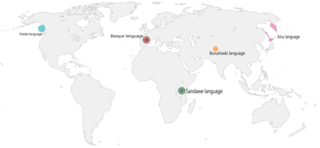
A language isolate is a language that has no demonstrable genetic relationship with another language. Basque in Europe, Ainu in Asia, Sandawe in Africa, Haida and Zuni in North America, Kanoê in South America, and Tiwi in Australia are all examples of language isolates. The exact number of language isolates is yet unknown due to insufficient data on several languages.

The Indigenous languages of the Americas are the languages that were used by the Indigenous peoples of the Americas before the arrival of non-Indigenous peoples. Over a thousand of these languages are still used today, while many more are now extinct. The Indigenous languages of the Americas are not all related to each other, instead they are classified into a hundred or so language families, as well as a number of extinct languages that are unclassified due to the lack of information on them.

The Hokan language family is a hypothetical grouping of a dozen small language families spoken mainly in California, Arizona, and Baja California.

Mesoamerican languages are the languages indigenous to the Mesoamerican cultural area, which covers southern Mexico, all of Guatemala and Belize and parts of Honduras, El Salvador, Nicaragua and Costa Rica. The area is characterized by extensive linguistic diversity containing several hundred different languages and seven major language families. Mesoamerica is also an area of high linguistic diffusion in that long-term interaction among speakers of different languages through several millennia has resulted in the convergence of certain linguistic traits across disparate language families. The Mesoamerican sprachbund is commonly referred to as the Mesoamerican Linguistic Area.

Uto-Aztecan, Uto-Aztekan or Uto-Nahuatl is a family of indigenous languages of the Americas, consisting of over thirty languages. Uto-Aztecan languages are found almost entirely in the Western United States and Mexico. The name of the language family was created to show that it includes both the Ute language of Utah and the Nahuan languages of Mexico.
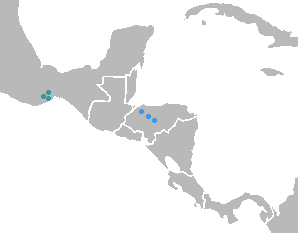
Tequistlatec, also called Chontal, are three close but distinct languages spoken or once spoken by the Chontal people of Oaxaca State, Mexico.
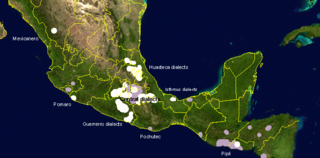
The Nahuan or Aztecan languages are those languages of the Uto-Aztecan language family that have undergone a sound change, known as Whorf's law, that changed an original *t to before *a. Subsequently, some Nahuan languages have changed this to or back to, but it can still be seen that the language went through a stage. The best known Nahuan language is Nahuatl. Nahuatl is spoken by about 1.7 million Nahua peoples.

Amuzgo is an Oto-Manguean language spoken in the Costa Chica region of the Mexican states of Guerrero and Oaxaca by about 44,000 speakers. Like other Oto-Manguean languages, Amuzgo is a tonal language. From syntactical point of view Amuzgo can be considered as an active language. The name Amuzgo is claimed to be a Nahuatl exonym but its meaning is shrouded in controversy; multiple proposals have been made, including 'moss-in'.

The Zapotec languages are a group of around 50 closely related indigenous Mesoamerican languages that constitute a main branch of the Oto-Manguean language family and which is spoken by the Zapotec people from the southwestern-central highlands of Mexico. A 2020 census reports nearly half a million speakers, with the majority inhabiting the state of Oaxaca. Zapotec-speaking communities are also found in the neighboring states of Puebla, Veracruz, and Guerrero. Labor migration has also brought a number of native Zapotec speakers to the United States, particularly in California and New Jersey. Most Zapotec-speaking communities are highly bilingual in Spanish.
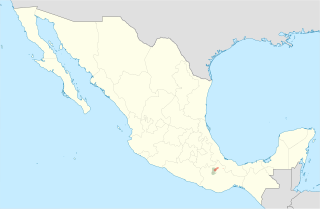
Cuicatec is an Oto-Manguean language spoken in Oaxaca, Mexico. It belongs to the Mixtecan branch together with the Mixtec languages and the Trique language. The Ethnologue lists two major dialects of Cuicatec: Tepeuxila Cuicatec and Teutila Cuicatec. Like other Oto-Manguean languages, Cuicatec is tonal.

Jicaquean, also known as Tolan, is a small language family of Honduras. There are two attested Jicaquean languages, Tol and Western Jicaque, which Campbell (1997) reports were about as distant as English and Swedish. Only Tol survives.
Huave is a language isolate spoken by the indigenous Huave people on the Pacific coast of the Mexican state of Oaxaca. The language is spoken in four villages on the Isthmus of Tehuantepec, in the southeast of the state, by around 20,000 people.
Lencan is a small family of nearly extinct indigenous Mesoamerican languages.
Pochutec is an extinct Uto-Aztecan language of the Nahuan branch which was spoken in and around the town of Pochutla on the Pacific coast of Oaxaca, Mexico. In 1917 it was documented in a monograph by Franz Boas, who considered the language nearly extinct. In the 1970s another investigator found two speakers around Pochutla who still remembered a few of the words recorded by Boas.
Mochoʼ is a Mayan language spoken by the Mocho' people of Chiapas, Mexico. A source stated that it was known as Qatok’, although this name has not received wide acceptance among the native speakers and the language, which is known as Mocho’ by both the Mocho’ people and the Mexican government. Mochoʼ has a dialect called Tuzantec (Muchu') spoken in Tuzantan, Chiapas. Alongside Jakaltek, Q’anjob’al, Chuj and Tojol-Ab’al, the Mocho’ language is part of the Q’anjobalan group from the western branch of Mayan languages.
Tol (Tolpan), also known as Eastern Jicaque, Tolupan, and Torupan, is spoken by approximately 500 Tolupan people in La Montaña de la Flor reservation in Francisco Morazán Department, Honduras.

The Indigenous people of Oaxaca are descendants of the inhabitants of what is now the state of Oaxaca, Mexico, who were present before the Spanish invasion. Several cultures flourished in the ancient region of Oaxaca from as far back as 2000 BC, of whom the Zapotecs and Mixtecs were perhaps the most advanced, with complex social organization and sophisticated arts.
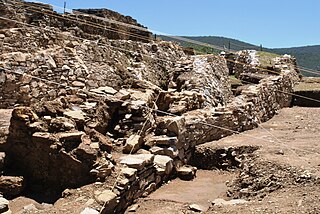
Ixcateopan is an archaeological site located in the town and municipality of Ixcateopan de Cuauhtémoc, 36 kilometers from Taxco, in the isolated and rugged mountains of the northern part of the Mexican state of Guerrero.
Huamelultec is one of the Chontal languages of Oaxaca, Mexico. It is spoken in the Oaxacan municipalities of San Pedro Huamelula, Santiago Astata, and Tehuantepec . The name has been misspelled Tlamelula.
Western Jicaque, also known as Jicaque of El Palmar and Sula, now extinct, was a Jicaquean language spoken around El Palmar, Cortés Department, near Chamelecón in Honduras.












